Galería RGR presents at SP-Arte 2025 a curatorial proposal that explores the convergence of different artistic languages and periods, promoting a discourse that connects the tradition of Latin American modern art with the most experimental contemporary practices.
The exhibition brings together key figures in kinetic and geometric art, such as Carlos Cruz-Diez, Julio Le Parc, Jesús Rafael Soto, Oswaldo Vigas and GEGO, whose formal and conceptual investigations have redefined the relationship between the work of art, the viewer and space. Through a rigorous focus on the interaction of light, color and movement, these works activate sensory perception and question traditional notions of artistic objecthood.
In parallel, the selection of contemporary artists -Jeppe Hein, Hilma's Ghost, Magali Lara, Matthias Bitzer, Francisco Muñoz, Galia Eibenschutz, Mercedez Azpilicueta, Patrick Hamilton, Karina Aguilera and Felipe Pantone- proposes a critical and contemporary counterpoint, addressing contemporary issues from interdisciplinary perspectives, incorporating elements of performance, installation, expanded painting and conceptual practice.
The dialogue between these two temporalities allows Galeria RGR to propose an expanded reading of art history, where continuity and rupture coexist, generating a space for reflection on the evolution of visual languages and their capacity to question the public from a critical and poetic perspective.

Karina Aguilera Skvirsky (Rhode Island, USA, 1967)
Karina Aguilera Skvirsky is a multidisciplinary Ecuadorian and Jewish-American artist based in New York. Through video, performance, and photography, her practice navigates broader questions of place, identity, and nationhood. Her main subjects of interest are abstraction, politics, humor, feminism, and history. With her work, she has explored social topics such as the African diaspora in both the North and the South of the hemisphere, the complexities of indigeneity, and the legacies of colonialism.
Aguilera Skvirsky’s work has been exhibited internationally in group and solo shows in renowned galleries and museums, highlighting, among them: Museo de la Ciudad, Cuenca, Ecuador (2021), Photoville, The Clemente, NY, USA (2021), Museo Amparo, Puebla, Mexico (2019), Centro de la Imagen, Mexico City, Mexico (2018), The Deutsche Bank, NY, USA (2018), Ponce + Robles Gallery, Madrid, Spain (2017), The Institute of Contemporary Art, PA, USA (2016), Instituto Cervantes, Rome, Italy (2013), The Montclair Art Museum, Montclair, NJ, USA (2013), The Aldrich Contemporary Art Museum, CT, USA (2007), El Museo del Barrio, NY, USA (2006), and Sara Meltzer Gallery, NY, USA (2006).
Throughout her career, she has been recognized with various grants from such as Anonymous Was A Woman (2019), The National Association of Latino Arts Culture (2018), Jerome Foundation Fellowship (2015), Fulbright Scholar Program (2015), Puffin Foundation (2006), among others.
She currently lives and works between New York and Ecuador.
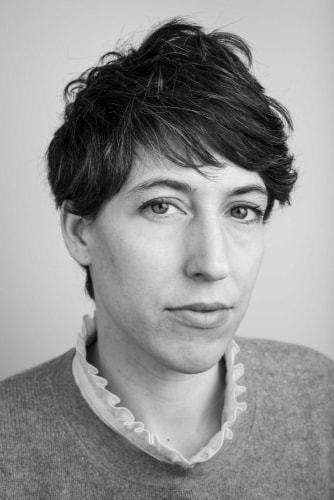
Mercedes Azpilicueta (La Plata, Argentina, 1981)
Mercedes Azpilicueta is an artist best known for her language-based works who calls herself a dishonest researcher.
Through extensive research work, from art history to popular music, from literature to street culture, her work brings together diverse figures from the past and present, and reflects on their dissident trajectories including their voices, forms, texts, traces and memories in a multi-layered work. Far from falling into cold reverence or archival fascination, her work successfully addresses the body with all its defects and potential embracing its fragility, as well as its capacity for resistance and care.
Azpilicueta’s practice has recently evolved towards exploring the theatrical possibilities of sculpture and installation. Disguised as sculptures, her pieces should not be taken for granted, as they have the potential to be activated in various ways such as scores, sets, props, mnemonic devices or records.
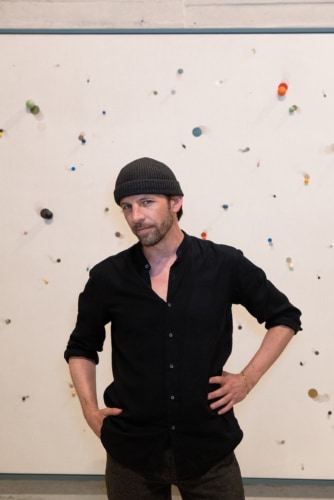
Matthias Bitzer (Stuttgart, Germany, 1975)
Matthias Bitzer’s work is poetic and enigmatic, combining figurative painting with abstraction and ornamental geometries. His passion for literature, poetry, and science produce an optical network that connects gaps in our perception of time and space. His source of inspiration derives from a broad range of often forgotten historical figures, including Emily Dickinson.
Bitzer’s unique artistic language is based on formal and conceptual themes that diverge between abstraction and
figuration. He references artists from the 19th and 20th centuries such as Lászlò Moholy Nagy or Oskar Schlemmer. Nevertheless, his work goes beyond what his predecessors explored.
Bitzer unfolds a new perspective on modernism by creating a visual cosmos that immerses the viewer in a world of figuration in geometric patterns, overlapped images, and abstraction. In that sense, Bitzer is concerned with identity as an existential stance and constantly unveils the fragility of what we take as “truth.”
Currently lives and works in Berlin, Germany.
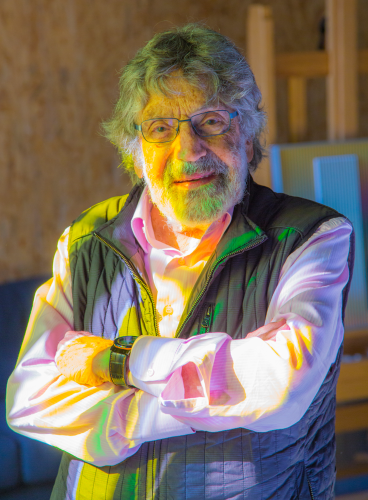
Carlos Cruz-Diez (Caracas, Venezuela, 1923 - Paris, France, 2019)
Carlos Cruz-Diez was one of the most prominent figures of Kinetic art whose work has been based upon the revaluation of color as an experience in itself, as a phenomenon of light in which interpretation or cultural background is no longer relevant. Part of this research comes from photography. His artistic practice invites viewers to become conscious of how perceptual relationships constitute the aesthetic, and how every context implies a different approach and construction of the same artwork.
His research has positioned him as one of the key thinkers of the 20th century when it comes to color. He has contributed majorly to the possibility of rethinking the relations between artist, spectator, and art, framing them within a participative process rooted exclusively in the use of color. In 1959 Cruz-Diez began his series Physichromie, through which he realized the idea of chromatic autonomy and its impact upon the viewer’s environment; one of the results was an important body of work that in later decades surpassed the limits of painting and explored the transformation of diverse spaces through the manipulation of color.
His work emphasizes participation and interaction, spatial perception, and movement as the key elements of the artistic experience.
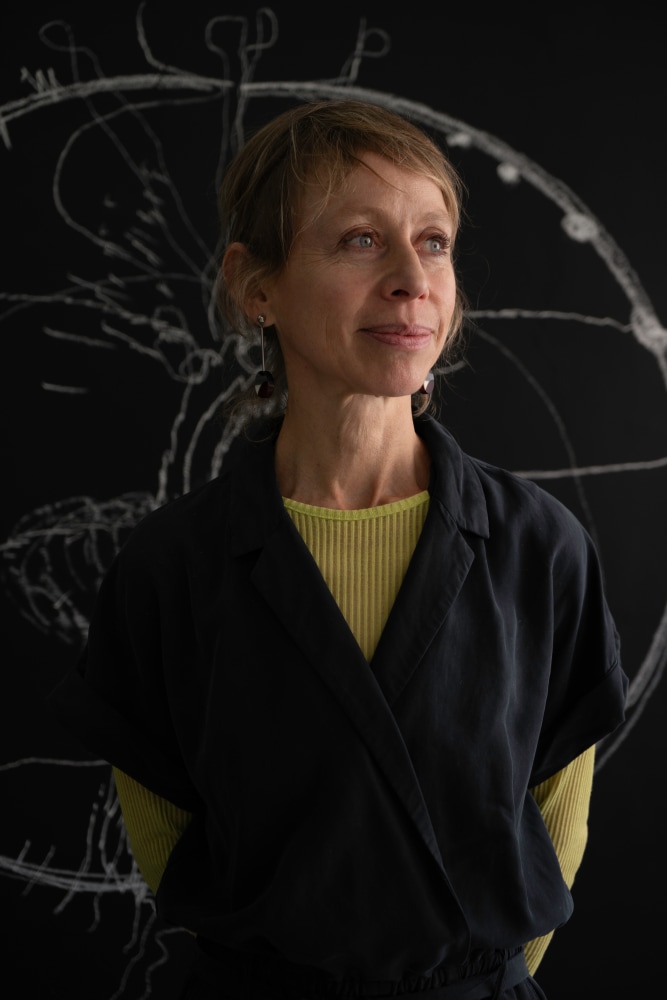
Galia Eibenschutz (Mexico City, Mexico,1970)
Multidisciplinary artist, she develops her work between the performing and visual arts. She explores themes such as the registration of movement and the passage of time, and the scenic presence of the body and its projection in architecture. She studied Visual Arts at the Universidad Nacional Autónoma de México's Escuela Nacional de Artes Plásticas and a MFA from DasArts in Amsterdam.
The artist's drawing and movement laboratory -presented at numerous universities and art spaces in Mexico and the United States- is a fundamental part of her practice. She has exhibited work at Mexican venues such as Arte Abierto, Casa Wabi, the Hospicio Cabañas, the Museo de Arte Carrillo Gil, the Museo Jumex, the Museo Tamayo, the Museo Universitario del Chopo, Laboratorio Arte Alameda, Sala de Arte Público Siqueiros and Teatro de la Danza.
She has also collaborated with international spaces such as Assembly (New York), Center for the Arts and Communication (Art Basel, Miami), Stedelijk Museum voor Actuele Kunst (SMAK, Amsterdam), The Cedar Cultural Center (Minneapolis) and YYZ (Toronto), among others. She was selected as a choreographer by the Mcknight Foundation (2019) and as a commissioned artist for the 15 Bienal FEMSA (2024).
She is currently a member of the Sistema Nacional de Creadores de Arte de México.
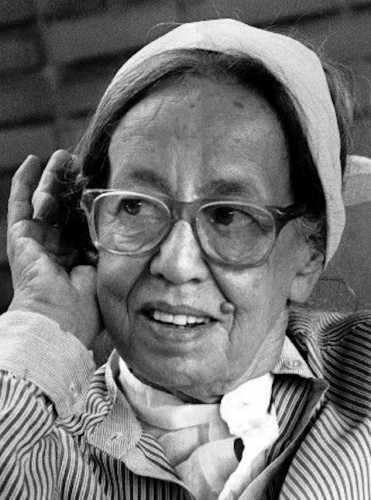
Gertrud Goldschmidt (Hamburg, Germany, 1912 - Caracas, Venezuela, 1994)
Gego (Gertrud Goldschmidt) studied architecture and engineering at the Stuttgart Technical School, Germany, where she was tutored by architect Paul Bonatz, following the models proposed by the Bauhaus and Russian Constructivism. In 1939, due to persecution from the Nazi regime, the artist migrated to Venezuela, settling in Caracas.
In her new country of residence, Gego dedicated to design, furniture making, and the development of architectural projects. Additionally, she began a long teaching career that would lead her to be one of the founders and subsequent professors of the Institute of Design from the Neumann Foundation (Caracas) in 1964. It was during the 1950s that she deepened her artistic practice, which was at first of a figurative, expressionist type, and then —already in dialogue with kinetic artists like Alejandro Otero and Jesús Rafael Soto— of a sculptural type, grounded upon spectator participation, action, and movement as key principles of production.
Her work is characterized by the experimentation with lines upon space, conceived as the most elemental unit of drawing, as well as for the innovative use of the grid, a form intimately related to abstraction in modern art. In 1969, Gego exhibited Reticulárea at the Caracas Museum of Fine Arts, an installation whose importance in the history of art cannot be understated. It is an assembly of modular pieces made of steel and aluminum, which constitute an apparently organic vast structure, which experience is marked by the rupture of the spaces that hold them in place.
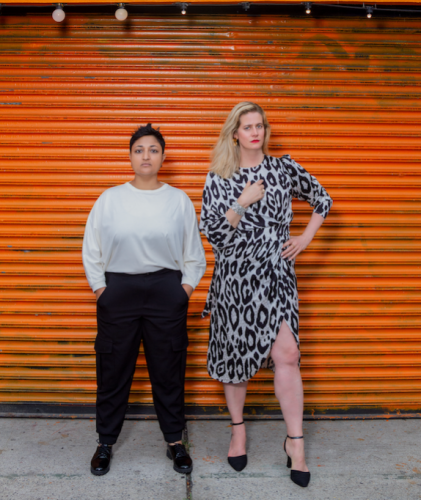
Hilma’s Ghost (Brooklyn, USA, 2020)
Hilma’s Ghost is a feminist artist collective that was co-founded by artists and educators Sharmistha Ray and Dannielle Tegeder at the peak of the pandemic, in 2020. The essence of their artistic collaboration lies in acknowledging mysticism as a wellspring of collective wisdom that has fostered personal resilience and sparked aesthetic ingenuity for women artists across eras.
Through exhibitions, workshops, and publications, the collective forges connections between artists and healers, innovating novel, liberatory practices tailored to women, non-binary, and trans artists of the contemporary era. Over the past couple of years, Hilma’s Ghost has cultivated undertakings that champion experimental teaching methods, transcultural dialogue, and the scaffolding of communities, all through the prism of feminism, geometric abstraction, and spirituality.
Most recent solo, group exhibitions and projects include Radical Spirits: Tarot Automatism, and Feminist Histories at Hill-Stead Museum, Connecticut, USA (2022); Enchantments: Bottled Devotionals of Divine Feminine Spirits at the Aldrich Contemporary Art Museum, Connecticut, USA (2024); Queer histories at the Museu de Arte de São Paulo, Brazil (2024); Chromatic Altar at Guggenheim Museum, New York, USA (2024); and the upcoming La hora de la estrella exhibition at Galería RGR, Mexico City, Mexico (April 2025).
Ray and Tegeder work together in Brooklyn, New York.
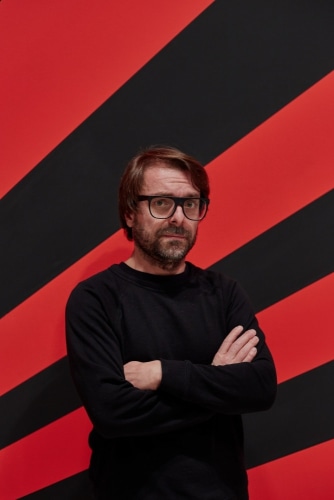
Patrick Hamilton (Lovaina, Belgium, 1974)
Patrick Hamilton studied art at the Universidad de Chile. His work is characterized by a political interest that promotes the return of the social burden that abstractionism and conceptual art had at their time. With clear references to the 20th-century avant-gardes, the artist develops critiques in which the economy of visual language allows him to be incisive and forceful with his ideas.
The works belonging to his series Abrasive Paintings, for instance, are made with black, red, yellow or white-colored sandpaper, with which the artist makes geometric patterns, almost always rectangular, alluding to bricks. A design that first appears innocuous hides an aggressive materiality, in a way that contrasts the “coldness” and simplicity of rational design with a strong emotional base. More widely, Hamilton seeks to make connections between these sorts of clashes and the contexts of the countries to which he holds personal links, be that Spain or Chile, referring to their social problems and their historical roots.
Thus, through distinct media, from painting to urban interventions, Hamilton centers his reflections on the analysis of social and political tensions.
He currently lives and works between Madrid, Spain, and Santiago, Chile.
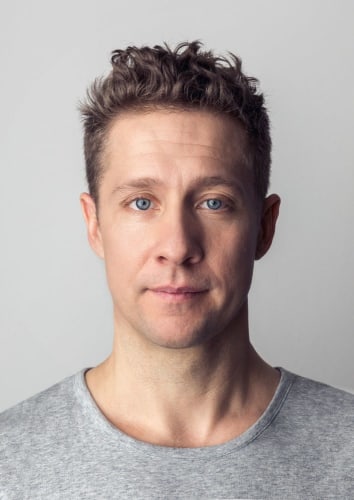
Jeppe Hein (Copenhagen, Denmark, 1974)
Jeppe Hein studied at the Royal Danish Academy of Arts in Copenhagen and the Städelschule in Frankfurt. Hein is widely known for his production of experiential and interactive artworks that can be positioned between the junction of art, architecture, and technical inventions.
Unique in their formal simplicity and notable for their frequent use of humor, his works engage in a lively dialogue with the traditions of Minimalist sculpture and Conceptual art of the seventies. Hein’s pieces often feature surprising and captivating elements that place spectators at the center of events and focus their experience and perception on the surrounding space. The influence of Conceptual art movements on Hein’s work can be seen in projects such as One Wish for You (2020), where he created balloons that looked like they were made of plastic and inflated by helium but were actually made with fiberglass, chrome lacquer and a magnet that holds them to the ceiling.
The material ambiguity of the piece lies in the naturalness with which the balloon moves against the most subtle breeze and the technical process behind it, something that allows Hein to show how our understanding and perception of daily objects are more in a subjective assessment than in their materiality itself. At the same time, the distortion of space that can be seen on the surface of the balloons reaffirms the idea that our gaze is under constant transformation.
He currently lives and works in Berlin, Germany.
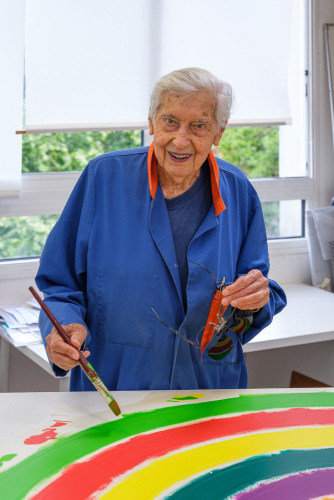
Julio Le Parc (Mendoza, Argentina, 1928)
Julio Le Parc is one of the most renowned figures in the field of research, and experimental visual arts focused on modern Op-Art, whose influence spans from the mid-20th century to the present. He studied at the National University of the Arts in Argentina, where he was first interested in the relationships between light and form. Immersed in the radical environment of the student movements of his native country, between 1955 and 1958, he participated in the occupations of the Academy of Fine Arts and the reformulation of its programs, oriented by the proposals of avant-garde artists such as the Arte Concreto-Invención movement and where he met the influential art critic Jorge Romero Brest.
In 1958 he traveled to Paris after receiving a scholarship from the French Cultural Service, where he met artists such as Victor Vasarely and other important representatives of Kinetic art. From them, Le Parc extracted not only its formal proposals regarding movement but also its political implications to articulate aesthetic experiences without the need for previous knowledge or any sort of familiarity with the art world. Such implications derived into collective practices of the Groupe de Recherche d’Art Visuel (GRAV), of which he was a founding member, guided by a rejection of the position of art in capitalism. The collective emphasized anonymity and the participation of spectators through the application of industrial, mechanical, and kinetic techniques alike.
Afterwards, he participated in the Atelier Populaire during May 68 in France, as well as in various avant-garde radical publications, anchoring his production – always close to Kinetism – in a social and political commitment that conceives spectators no longer as participants in the work, but as co-authors of it.
Currently lives and works in Paris, France.

Magali Lara (Mexico City, Mexico, 1956)
Magali Lara is considered a central figure of feminist postmodern art in Mexico. She has a degree in Visual Arts for Plastic Expression from the Universidad de Guadalajara and a Master of Arts from the Universidad Autónoma del Estado de Morelos. With more than 40 years of artistic practice based on collaborations with poets and performers, Lara has developed a multidisciplinary practice that explores issues related to the unconscious, everyday life, emotions, the body, the feminine, and the “otherness”.
Influenced by women painters of the Mexican school such as María Izquierdo, Olga Costa, and Frida Kahlo, Lara takes up an interest in still life, objects, and dreamlike atmospheres. These elements are used to compose a unique symbolic language that she has brought to the fields of animation, drawing, writing, ceramics, the artist’s book, painting, and textiles. Mainly associated with Conceptual art, Magali Lara has been constantly working on a “poetics” that delves into the body, intimacy, desire, motherhood, childhood, sexuality, and everyday life; all this from a perspective of subjectivity. Starting from the ordinary and the visceral of the human body allows her to make a philosophical review of the human condition, something that the artist considers essential in the social function of art.
Since the nineties, she has worked at the Facultad de Artes de la Universidad Autónoma de Morelos. She is currently part of the Academic Body of the Master’s Degree in art production and participates as a jury in several biennials and artistic production, and as a study plan advisor in various arts education institutions. She is a member of the Sistema Nacional de Creadores FONCA, which she accessed for the seventh time in the 2020-2023 period. In 2019 she received the Medal of Merit in Arts from Mexico City’s Congress and in 2024 she was awarded the Medal of Fine Arts by the Instituto Nacional de Bellas Artes y Literatura in Mexico.
She currently lives and works in Cuernavaca, Mexico.
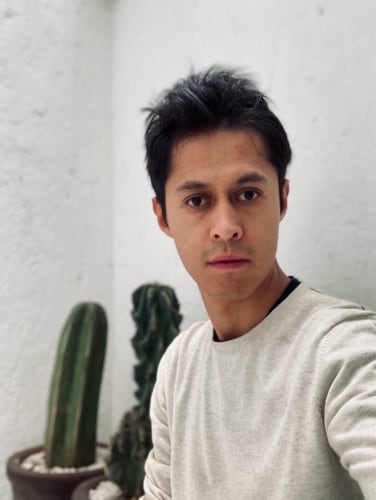
Francisco Muñoz (Tlaxcala, Mexico, 1986)
Francisco Muñoz’s multidisciplinary practice includes ceramic, drawing, collage, painting, textiles, and installations. He studied at the Escuela Nacional de Pintura, Escultura y Grabado, La Esmeralda, in Mexico City, and later at the École nationale supérieure des beaux-arts in Lyon, as part of an artistic fellowship program. His work is placed in the questioning and analysis of national identities, especially in aesthetic terms. The artist is originally from Tlaxcala, a crucial place in the imaginary produced by the official history of Mexico regarding the period of the Conquest. In that sense, Muñoz approaches pre-Columbian images and symbols as a part of present-day speeches that are necessary to question and explore.
One of the main axes of his work is the relationship that objects have with different contexts and how their meanings can be reordered through material modifications, conceptual associations, or painting interventions. The possibilities represented by the adaptation of objects to different environments are key to Muñoz’s practice: the identity of each piece is based on multiplicity, on the encounter between its “original” meanings and those it assimilates, both in the process of artistic work and at the point of encounter with its viewers. This syncretism directly connects the conceptual with the material, a line on which his work unfolds. Muñoz's work can be found in the Alain Servais Collection (Belgium) and in various private collections in Mexico.
He currently lives and works in Mexico City.
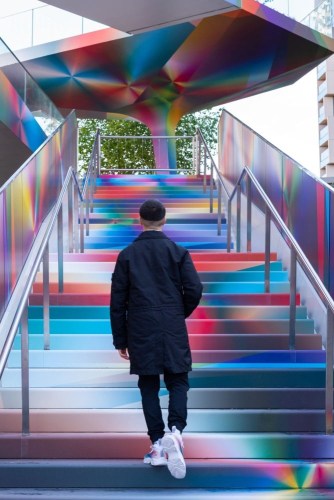
Felipe Pantone (Buenos Aires, Argentina, 1986)
He began his practice as a teenager, making graffiti in Torrevieja, in the south of Spain. Calligraphy and typography, the fundamental focus of graffiti, were the platform from which the artist undertook the development of an abstract or geometric visual language that aims to be both accessible and democratic, parallel to current technological speech. Pantone's work maintains a historical connection with current production methods and with the visual references of the hyper-connected and digitized society. His work is a meditation on the ways in which we consume visual information in current times.
Abstraction is first used as stylistic branding and then poured towards the references of the present time full of infographics, statistics, and visual representations of data that synthesize realities into quickly understandable formats. With this, Pantone reflects on the impact of the digital revolution and global communication on the constitution of the contemporary subject. In today’s accelerated world of industrial production with light, color or previously impossible visual experiences, Pantone recognizes chromatic combinations —such as the glitch or technological failure— as visual experiences linked to contemporary culture. The result is a language that moves between technology and the fine arts, taken to several applications.
Among his most outstanding public installations are the murals commissioned by the Palais de Tokyo in Paris, France; the mosaic at the Universidad Politécnica de Valencia, Spain; the murals in two buildings of the Tecnológico de Monterrey, Mexico; the mural Optichromie at the Albright-Knox Art Gallery in Buffalo, USA; and the mural 300,000 Km/s on Faria Lima Avenue in São Paulo, Brazil.
He currently lives and works in Valencia, Spain.
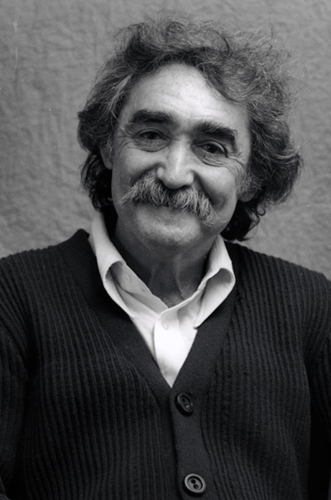
Jesús Rafael Soto (Ciudad Bolívar, Venezuela, 1923 - Paris, France, 2005)
Jesús Rafael Soto was an influential and central figure of post-war global modernism. He participated in the group exhibition Le mouvement (1955), at the Denise René Gallery in Paris, one of the foundational moments of the style. Throughout his career, he was prominent for the redefinition of the social role of art, rooted in wide research about the spatial-temporal quality of the artistic object.
Soto studied Fine Arts in Caracas, then he moved to Paris in 1950, where he became a part of the international group of artists that sought to renew the experimental art scene. Even though he has been commonly associated with Op Art, Soto’s work is rather characterized by the continuous study of movement and the dematerialization of the form, producing kinetic constructions where the active participation of the viewer is fundamental.
In 1958 he began Vibraciones, a series consisting of the overlap, in various levels, of grids and mobile objects that create infinite possibilities of vibrations and variations. Soto managed to create works accessible to all people, without marking the differences of age or cultural capital of the public, appealing to the very experience of the viewer in relation to the artistic object.

Oswaldo Vigas (Valencia, Venezuela, 1923 - Caracas, Venezuela, 2014)
Oswaldo Vigas is a Venezuelan artist best known as a painter and muralist, but his work spanned painting, sculpture, print, drawing, ceramic, and tapestry. Predominantly recognized as a self-taught artist, Vigas avoided the artistic currents of his environment and instead ventured to build his artistic language, inspired by the magical, the mythical, and the telluric of the Latin American imaginary, a trend that would be the common thread of his oeuvre.
In 1954 Vigas represented Venezuela at the Venice Biennale. In 1992 he participated in the XXVI International Prize of Contemporary Art of Monaco, receiving the first prize, and in 1999, the Iberian-American FIA Art Fair chose him as the honored artist. Oswaldo Vigas died in Caracas in 2014 at the age of 90 years.
Today, his works are part of the collections of important public institutions such as the Museum of Fine Arts, Houston; the San Francisco Museum of Modern Art; the Art Museum of the Americas, OAS, in Washington D.C.; the Musée Des Beaux Arts D’Angers, and the Musée Des Beaux-Arts in Reims; the Museo de Arte Moderno de Bogotá; the Museo Nacional de Bellas Artes in Santiago de Chile to name a few; as well as in numerous important private collections around the world.
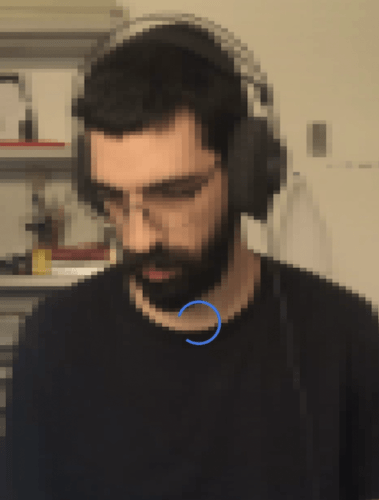
Pedro Zylbersztajn (São Paulo, Brasil, 1993)
From the interactions between drawing, writing, editing, publishing, performing, collecting and sounding, the artistic practice of Pedro Zylbersztajn investigates the circular relationship between image, language, protocols of everydayness, technology, and authority. His research employs strategies of reading with the intention of defamiliarizing the way in which commonplace devices are used to build and enforce specific (and sometimes violent) relations between the different realities that surround us. With that, he seeks to create altered relational spaces, which are more reliant on ambiguity and negotiation.
Zylbersztajn holds a Master’s degree from the MIT Program in Art, Culture, and Technology (USA), and was a Postgraduate Fellow at the Art by Translation research program (France, 2019-2021). He has participated in exhibitions, fairs, panels, and publications internationally, among which is the solo show As if i were the photographer: Carlos Amadeu Gouvêa, 1971 (Casamata, Rio de Janeiro, 2016), the performance brickwork (Americas Society Visual Arts, New York, 2018); and the group exhibitions Trembling Thinking (Americas Society, NY, 2018) and Time Capsule 2045 (Palais des Beaux-arts de Paris, FR, 2021, Musée d’Art et Histoire de Genève, CH, 2022). He was also part of the 2022 FRONT Triennial, Cleveland, and the 12th São Paulo International Architecture Biennial (CCSP, 2019).
More recently, his artistic practice seeks to expand toward collective environments in which the sense of shared responsibilities overrides authorial intentions. Currently, is co-editor -in collaboration with the Index Literacy Programme- of a publication titled Indexing Imaginaries (DATA Browser/Open Humanities Press, 2022), which explores the concept of indexing as a form of power. He is involved in the micro-histórias initiative at Casa do Povo (SP), which focuses on researching institutional history and he is the coordinator of a multidisciplinary research group called Disposições Infraestruturais, which delves into issues related to art, architecture, and planetarity.
He currently lives and works in São Paulo, Brazil.